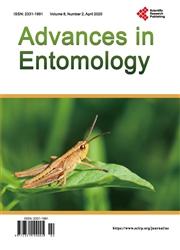Field Exploration of the Efficacy of Some Friendly Products in Combination with Some Pesticides against the Red Palm Weevil Rhynchophorus ferrugineus (Olivier) (Coleoptera: Curculionidae) and Its Effect on Total Carbohydrates and Micronutrients in the Resulting Date Fruits
引用次数: 1
Abstract
Experiments were carried out against the red palm weevil, Rhynchophorus ferrugineus (Oliv.) (RPW in a private palm orchard containing varieties of Samani (domestic) and Ikhlas (imported) infested with the red palm weevil Rhynchophorus ferrugineus (Oliv.) (RPW) in El-Marg area, Cairo Governorate, Egypt, using Petroleum oil, Jojoba oil, and Inorganic salts, singly and mixed with each of insecticides (Acetamiprid, Profenofos, Dimethoate) by injection and spraying of infested palm trunks, as well as pouring these substances into pits around the roots of the affected palm trees. The data showed that Acetamiprid was the most effective against RPW. The effective mixtures against R. ferrugineus were Jujuba oil with Acetamiprid, also used car oil with inorganic salts, which resulted in 100% recovery of treated palm. Continuing treatment of infested palms for 6 consecutive months by injecting used car oil mixed with inorganic saline solution resulted in 100% recovery for both date palm cultivars. Spraying these substances on the affected trunks had no effect on RPW. Pouring the tested solutions around the roots of the affected palm had the least effect against RPW. Injection of the tested pesticides into the ganic salt, compared to the control group. There is a significant difference between the treatments.几种友好产品联合农药对红棕象甲(鞘翅目:Curculionidae)的田间防治效果及对红枣果实中总碳水化合物和微量元素的影响
在埃及开罗省El-Marg地区的一个私人棕榈园内,用石油、荷荷巴油和无机盐单独或与杀虫剂(醋氨虫、丙烯虫、乐果)混合,对红棕榈象(Rhynchophorus ferrugineus (Oliv.)) (RPW .)进行了防治试验,该试验含有被红棕榈象(Rhynchophorus ferrugineus, Oliv.) (RPW .)侵染的Samani(国产)和Ikhlas(进口)品种。并将这些物质倒入受影响棕榈树根部周围的坑中。结果表明,扑热息痛对RPW的防治效果最好。枣树油与醋氨虫啉、汽车油与无机盐的混合处理对铁瘟螨有较好的防治效果,处理后的棕榈回收率为100%。连续6个月注射混合无机盐溶液的二手车油处理侵染棕榈树,两种椰枣品种的回收率均为100%。在受影响的树干上喷洒这些物质对RPW没有影响。在受影响的手掌根部周围倾倒测试溶液对RPW的影响最小。将试验农药注射到有机盐中,与对照组相比。两种治疗方法之间存在显著差异。
本文章由计算机程序翻译,如有差异,请以英文原文为准。
求助全文
约1分钟内获得全文
求助全文

 求助内容:
求助内容: 应助结果提醒方式:
应助结果提醒方式:


